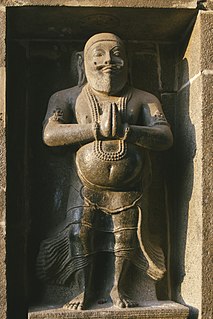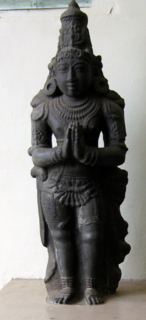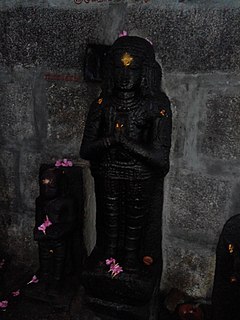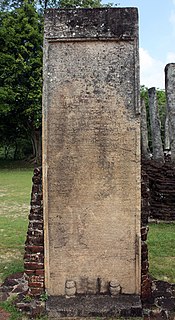
Uttama Chola was a Chola Emperor who ruled from 971 CE - 985 CE. According to Tiruvalangadu plates of Rajendra Chola, Madurantaka Uttama Chola's reign is placed after Aditya II. The latter may have been a co-regent of Parantaka II and seems to have died before he could formally ascend the throne. Uttama was the cousin of Parantaka II and was the son of the illustrious Sembiyan Mahadevi and Gandaraditya.

The Pandya dynasty, also referred to as the Pandyas of Madurai, was an ancient dynasty of South India, and among the three great kingdoms of Tamilakam, the other two being the Cholas and the Cheras. Extant since at least the 4th to 3rd centuries BCE, the dynasty passed through two periods of imperial dominance, the 6th to 10th centuries CE, and under the 'Later Pandyas'. The Pandyas ruled extensive territories, at times including regions of present-day South India and northern Sri Lanka through vassal states subject to Madurai.

Rajaraja I born Arulmoli Varman often described as Rajaraja the Great was a Chola emperor who reigned from 985 CE to 1014 CE and was the most powerful king in south at his time chiefly remembered for reinstating the Chola power and ensuring its supremacy in South India and Indian Ocean.

Kulottunga I also spelt Kulothunga, was an 11th-century Chola Emperor who reigned for fifty-two years. He also served as the Eastern Chalukya Emperor succeeding his father Rajaraja Narendra. His birth name was Rajendra Chalukya. He was one of the sovereigns who bore the title "Kulottunga", literally meaning "the exalter of his race" in Tamil, succeeding his cousin Athirajindra. He is related to the Chola dynasty though his mother's side and the Eastern Chalukyas through his father's side. His mother, Ammangaidevi, was a Chola princess and the daughter of emperor Rajendra I. His father was king Rajaraja Narendra of the Eastern Chalukya dynasty who was the nephew of Rajendra I and maternal grandson of Rajaraja I. According to historian Sailendra Nath Sen, his accession marked the beginning of a new era and ushered in a period of internal peace and benevolent administration.

Rajendra Chola I often referred to as Rajendra the Great, and also known as Gangaikonda Chola was a Chola Emperor who ruled between 1014 and 1044 CE. Rajendra succeeded his father Rajaraja I in 1014 CE. The extensive Chola empire under Rajendra I included most parts of present-day south India, with the river Krishna as the northern limit, Sri Lanka and the Laccadives and the Maldives. He carried out a successful military expedition to the River Ganges through Orissa and Bengal and brought Ganges water to his new capital down in the Kaveri Delta, Gangaikondacholapuram. Rajendra's ambitious campaign against the Srivijaya is dated to c. 1025 CE. A number of strategic places along the Straits of Malacca came under Chola control as a result of this campaign. Rajendra was succeeded by Rajadhiraja I.

The Chola Dynasty was a Tamil thalassocratic empire of southern India, one of the longest-ruling dynasties in world history. The earliest datable references to the Chola are in inscriptions from the 3rd century BCE left by Ashoka, of the Maurya Empire. As one of the Three Crowned Kings of Tamilakam, along with the Chera and Pandya, the dynasty continued to govern over varying territory until the 13th century CE. Despite these ancient origins, the period when it is appropriate to speak of a "Chola Empire" only begins with the medieval Cholas in the mid-9th century CE.

Vijayalaya Chola was a king of South India who founded the imperial Chola Empire. He ruled over the region to the north of the river Kaveri.

Vikramaditya VI became the Western Chalukya King after deposing his elder brother Someshvara II, a political move he made by gaining the support of Chalukya vassals during the Chola invasion of Chalukya territory. Vikramaditya's reign is marked with the abolishment of the Saka era and the start of the Chalukya-Vikrama era. He was the greatest of the Western Chalukya kings and had the longest reign in the dynasty. He earned the title Permadideva and Tribhuvanamalla. He had several queens who ably assisted him in administration. One of his queens, Chandala Devi, a princess from the Shilahara ruling family of Karad was called Abhinava Saraswati for her skills as an artist. Queen Kethala Devi administered the Siruguppa region and Savala Devi was in charge of an Agrahara in Naregal. According to the historian Kamath, Vikramaditya VI was a "great king who ruled over South India" and he finds a "pride of place in Karnataka history". More inscriptions in Kannada are attributed to Vikramaditya VI than any other king prior to the Vijayanagara era.

The Cholas were a Tamil kingdom of the pre and post Sangam period. It was one of the three main kingdoms of South India. Their early capitals were Urayur or Tiruchirapalli and Kaveripattinam. Along with Pandyas and Cheras, Chola history goes back to the period when written records were scarce.

Medieval Cholas rose to prominence during the middle of the 9th century CE and established one of the greatest empires of India. They successfully united South India under their rule and through their naval strength extended their influence in Southeast Asia and Sri Lanka. They had trade contacts with the Arabs in the west and with the Chinese in the east.

The Later Chola dynasty ruled the Chola Empire from 1070 C.E. until the demise of the empire in 1279 C. E. This dynasty was the product of decades of alliances based on marriages between the Cholas and the Eastern Chalukyas based in Vengi, and produced some of the greatest Chola emperors such as Kulothunga Chola I. Even though the later Cholas are often referred to as Chalukya Cholas, there were two breaks in the line. Kulothunga Chola II and Rajadhiraja Chola II did not belong to the Chalukya Chola line. Kulottunga II was a grandson of Vikrama Chola and Rajadhiraja Chola II was not the son of Rajaraja Chola II.

Rajaraja II was a chola emperor who reigned from 1150 CE to 1173 CE. He was made his heir apparent and Co-Regent in 1146 and so the inscriptions of Rajaraja II count his reign from 1146. Rajaraja's reign began to show signs of the coming end of the dynasty.

Kulothunga III was a Chola emperor who ruled from 1178 to 1218 CE, after succeeding Rajadhiraja II. Kulothunga Chola III gained success in war against his traditional foes. He gained victories in war against the Hoysalas, Pandyas of Madurai, Cheras of Venad, the Sinhalese kings of Polonnaruwa, as well as the Chodas of Velanadu and Nellore. He also restored Chola control over Karur, which were ruled by the Adigaman chiefs as vassals of the Cholas. He drove out the Hoysalas under Veera Ballala II who had made inroads in the Gangavadi and adjoining areas of Tagadur in Kongu country in an effort expand their territory. However, during the last two years of his reign, he lost in war to the resurgent Pandyas, heralded a period of steady decline and ultimately, demise of the Cholas by 1280 CE. Kulottunga III had alliances with the Hoysalas. The Hoysala king Veera Ballala married a Chola queen called Cholamahadevi and gave his daughter Somaladevi in marriage to Kulottunga III.

Dravidian architecture, or the South Indian temple style, is an architectural idiom in Hindu temple architecture that emerged in the southern part of the Indian subcontinent or South India and in Sri Lanka, reaching its final form by the sixteenth century. It is seen in Hindu temples, and the most distinctive difference from north Indian styles is the use of a shorter and more pyramidal tower over the garbhagriha or sanctuary called a vimana, where the north has taller towers, usually bending inwards as they rise, called shikharas. However, for modern visitors to larger temples the dominating feature is the high gopura or gatehouse at the edge of the compound; large temples have several, dwarfing the vimana; these are a much more recent development. There are numerous other distinct features such as the dwarapalakas – twin guardians at the main entrance and the inner sanctum of the temple and goshtams – deities carved in niches on the outer side walls of the garbhagriha.

the Kingdom of Polonnaruwa was the kingdom that ruled the island of Sri Lanka and several overseas territories, from 1070 until 1232. The kingdom started expanding its overseas authority during the reign of Parakramabahu the Great.
Vikramabahu was a medieval king of Sri Lanka. Following the death of his father in 1029, Vikramabahu led the resistance movement against the Chola invaders of the country, ruling from the southern principality of Ruhuna. He spent a number of years building up his forces to drive out the Chola, but died before he could launch his military campaign.

Vijayabahu I, also known as Vijayabahu the Great, was a medieval king of Sri Lanka. Born to a royal bloodline, Vijayabahu grew up under Chola occupation. He assumed rulership of the Ruhuna principality in the southern parts of the country in 1055. Following a seventeen-year-long campaign, he successfully drove the Cholas out of the island in 1070, reuniting the country for the first time in over a century. During his reign, he re-established Buddhism in Sri Lanka and repaired much of the damage caused to infrastructure during the wars. He offered the Thihoshin Pagoda(Lord of Sri Lanka Buddha image) to Burma king Alaungsithu and it is now still in Pakokku.

Brihadishvara Temple locally known as Thanjai Periya Kovil, and also called Rajarajeswaram, is a Hindu Dravidian styled temple dedicated to the god Shiva located in South bank of Cauvery river in Thanjavur, Tamil Nadu, India. It is one of the largest Hindu temples and an exemplary example of a fully realized Tamil architecture. It is called as Dakshina Meru. Built by Chola emperor Rajaraja I between 1003 and 1010 AD, the temple is a part of the UNESCO World Heritage Site known as the "Great Living Chola Temples", along with the Chola dynasty era Gangaikonda Cholapuram temple and Airavatesvara temple that is about 70 kilometres (43 mi) and 40 kilometres (25 mi) to its northeast respectively.

Ponniyin Selvan is a historical fiction novel by Kalki Krishnamurthy, written in Tamil. The novel was first serialised in the weekly editions of Kalki from 29 October 1950 to 16 May 1954, and released in book form of five parts in 1955. In five volumes, or about 2,210 pages, it tells the story of early days of Arulmozhivarman (அருள்மொழிவர்மன்), who later became the great Chola emperor Rajaraja Chola I. Kalki visited Sri Lanka three times to gather information for it.

The Chola conquest and occupation of Anuradhapura Kingdom was a military invasion of the Kingdom of Anuradhapura by the Chola Empire. It initially began with the invasion of the Anuradhapura Kingdom in 993 AD by Rajaraja I when he sent a large Chola army to conquer the kingdom and absorb it into the Chola Empire. Most of the island was subsequently conquered by 1017 and incorporated as a province of the vast Chola empire during the reign of his son Rajendra Chola I. The Chola occupation would be overthrown in 1070 through a campaign of Sinhalese Resistance led by Prince Kitti, a Sinhalese royal. The Cholas fought many subsequent wars and attempted to reconquer the Sinhalese kingdom as the Sinhalese were allies of their arch-enemies, the Pandyas. The period of Chola entrenchment in northern Sri Lanka lasted in total about three-quarters of a century, from roughly 993 to 1070, when Vijayabahu I recaptured the north and expelled the Chola forces restoring Sinhalese sovereignty.


















